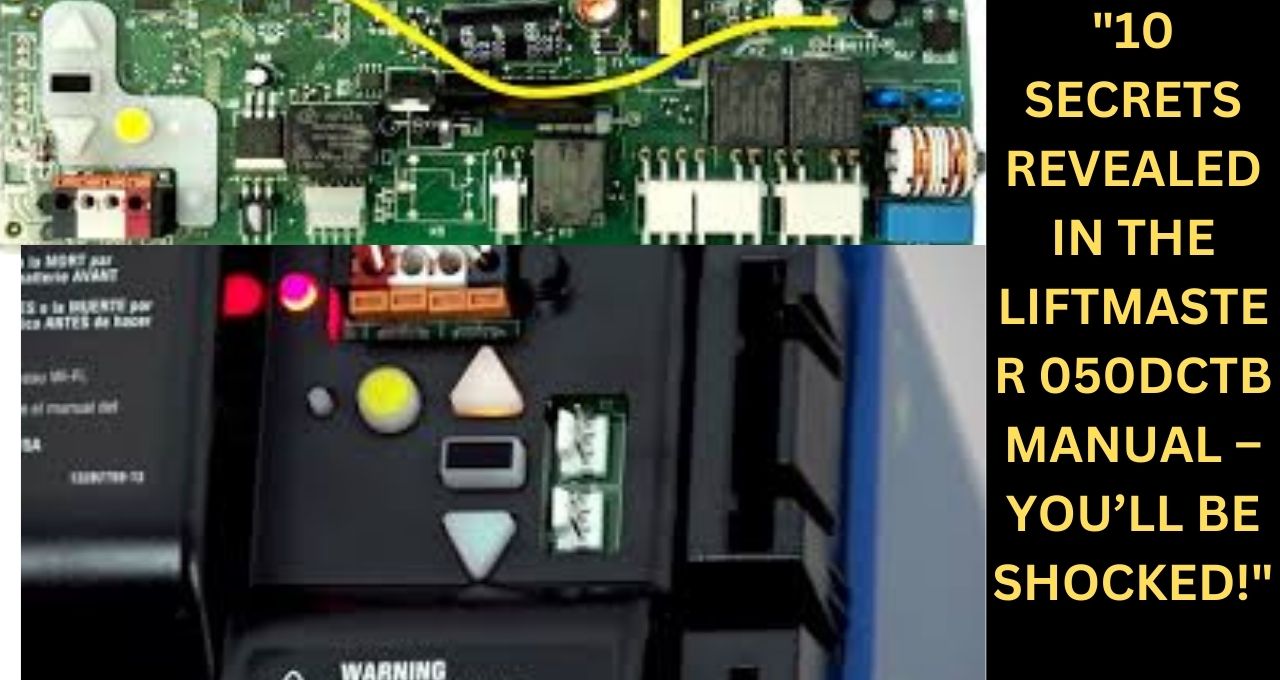
1. What is the LiftMaster 050DCTB Logic Board?
The LiftMaster 050DCTB logic board is an essential replacement part for LiftMaster garage door openers. It acts as the brain of the garage door opener, responsible for managing functions such as opening, closing, and other automated operations. If your garage door opener is malfunctioning, chances are the logic board needs replacement, and the 050DCTB is the ideal choice for specific models of LiftMaster and Chamberlain openers.
Table of Contents
ToggleThis logic board is primarily compatible with several models, making it versatile and a reliable option for homeowners. If your garage door opener’s behavior becomes erratic, or it stops functioning altogether, the logic board could be the issue, and knowing how to install and troubleshoot the 050DCTB will save you time and money.
2. Why You May Need to Replace the LiftMaster 050DCTB Logic Board
Your garage door opener is made up of various components, but the logic board plays a critical role. Over time, logic boards can fail due to several reasons, such as:
- Power surges: An unexpected power surge can fry the circuit board, rendering it useless.
- Water damage: If water seeps into the opener, it can damage the internal components.
- Wear and tear: Like any other piece of technology, logic boards degrade over time.
- Inconsistent operations: If your garage door opens or closes randomly, it’s likely that the logic board is malfunctioning.
Understanding why and when you may need to replace this part will make your life easier. Once you notice consistent problems with your opener, checking the LiftMaster 050DCTB manual and replacing the logic board could resolve the issue.
3. Tools and Equipment Needed for Installation
Before diving into the installation of the LiftMaster 050DCTB, make sure you have the following tools handy:
- Flathead screwdriver
- Phillips screwdriver
- Stepladder
- Needle-nose pliers
- Electrical tape
- Wire cutters
Having the right tools will make the installation process quicker and smoother. Without them, you could struggle with simple tasks like disconnecting wires or mounting the new logic board.
4. Step-by-Step Guide to Installing the LiftMaster 050DCTB
Step 1: Power Off the Garage Door Opener
Before you begin any installation, safety is paramount. Turn off the power to your garage door opener. This can typically be done by unplugging the unit or flipping the circuit breaker.
Step 2: Remove the Old Logic Board
Open the garage door opener casing to access the current logic board. Unscrew the board from its mount and disconnect the wires. Pay attention to how the wires are connected, or better yet, take a picture for reference later.
Step 3: Install the New LiftMaster 050DCTB
Place the new 050DCTB logic board into the garage door opener, ensuring it fits snugly in place. Carefully reconnect the wires exactly as they were connected to the old board. Use the picture you took earlier as a guide.
Step 4: Secure the Logic Board
Once the new board is in place and wired correctly, use screws to mount it firmly. Double-check that all connections are secure.
Step 5: Power On the Garage Door Opener
After installation, power the garage door opener back on by plugging it in or switching on the breaker. Watch closely for any signs of malfunction as the unit powers up.
Step 6: Test the Garage Door
Use your garage door remote to open and close the door. Test the limits and check for any erratic behavior, which could indicate improper wiring or a defective logic board.
5. How to Program the LiftMaster 050DCTB Logic Board
Once your LiftMaster 050DCTB is installed, programming is essential to ensure the garage door functions correctly. Follow these steps to program the logic board:
Step 1: Locate the “Learn” Button
The “Learn” button is usually found on the side of the opener motor or the wall unit. Press and hold the button until the LED light turns on.
Step 2: Sync Your Remote
Once the “Learn” button LED is lit, press the button on your garage door remote. The LED on the opener will blink, indicating that the remote is now synced with the garage door opener.
Step 3: Test Your Garage Door
After syncing, test the garage door by pressing the remote button. The door should respond by opening or closing. If not, you may need to repeat the process.
6. Troubleshooting Common LiftMaster 050DCTB Issues
Even with a brand-new LiftMaster 050DCTB, problems can occur. Below are some common issues and how to fix them:
Garage Door Won’t Respond to Remote
- Solution: Re-sync the remote following the steps above. If that doesn’t work, check the battery or consider replacing the remote.
Erratic Door Movement
- Solution: Ensure the logic board is properly installed. Also, check if any wires are loose or incorrectly connected.
Garage Door Doesn’t Close All the Way
- Solution: Adjust the opener’s limits using the adjustment screws located on the side of the motor unit. Consult the LiftMaster 050DCTB manual for detailed instructions.
7. Understanding LiftMaster 050DCTB Compatibility
The LiftMaster 050DCTB is compatible with a variety of LiftMaster and Chamberlain garage door openers. Knowing which models this logic board works with is crucial if you’re unsure whether it’s the right fit for your unit.
Compatible Models Include:
- LiftMaster 8355W
- LiftMaster 8365W
- Chamberlain B550
- Chamberlain C205
Make sure to cross-check your model number before purchasing the 050DCTB, to ensure compatibility and avoid unnecessary returns.
8. How Long Does the LiftMaster 050DCTB Last?
The lifespan of a logic board, including the LiftMaster 050DCTB, largely depends on its usage and the environment it operates in. On average, a logic board will last 7-10 years, but several factors can reduce its life, including:
- Electrical surges
- Extreme weather conditions
- High humidity levels
Performing regular maintenance on your garage door opener can extend the lifespan of your logic board. Ensure that the unit is free from dust and moisture, and consider using a surge protector to shield it from electrical spikes.
9. Where to Buy the LiftMaster 050DCTB Logic Board
You can purchase the LiftMaster 050DCTB logic board through various online and brick-and-mortar retailers. Some of the best places to buy include:
- Amazon: Offers fast shipping and reliable customer reviews.
- LiftMaster Official Website: Purchasing directly from the manufacturer ensures you’re getting a genuine product.
- Home Depot/Lowes: Convenient for those who prefer buying in-store and speaking with a specialist.
Make sure to compare prices across these platforms to get the best deal.
10. Final Thoughts on the LiftMaster 050DCTB Manual
The LiftMaster 050DCTB manual offers crucial insights into replacing, installing, and troubleshooting your garage door opener’s logic board. By following the steps provided in this guide, you can ensure your garage door opener runs smoothly for years to come.
Replacing a logic board may seem daunting at first, but with the right tools, the proper steps, and a bit of patience, the process can be quick and straightforward. Whether you’re a DIY enthusiast or a homeowner looking to save on repair costs, mastering the installation and programming of the LiftMaster 050DCTB will empower you to manage your garage door opener like a pro.
By understanding how to install and troubleshoot the LiftMaster 050DCTB logic board, you’ll maintain a reliable, functioning garage door system that meets all your needs.

hello friends
my name is Sumit kumar. I am the owner of this website and I share only garage door and lift master information and only informational posts on my website. And I have written this post myself and have given you only a good guide and information.
2 thoughts on “LiftMaster 050DCTB Manual: Comprehensive Guide for Setup, Use, and Troubleshooting”